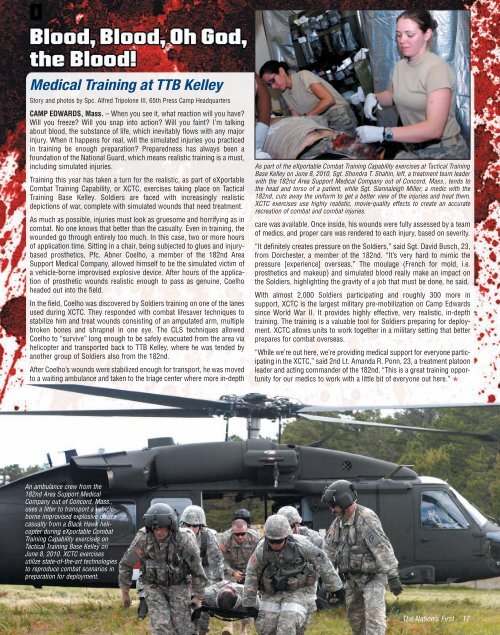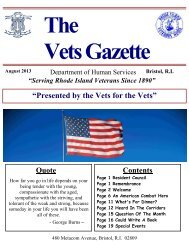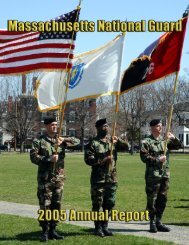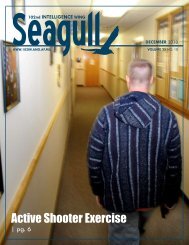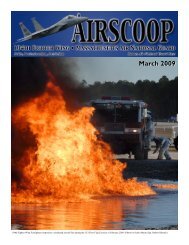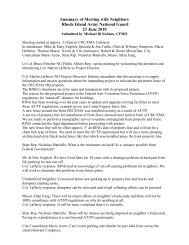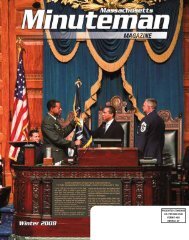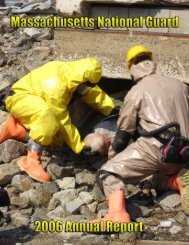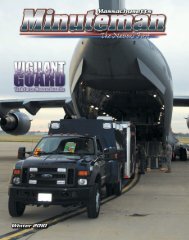Massachusetts Minuteman - Fall 2010 - STATES - The National Guard
Massachusetts Minuteman - Fall 2010 - STATES - The National Guard
Massachusetts Minuteman - Fall 2010 - STATES - The National Guard
You also want an ePaper? Increase the reach of your titles
YUMPU automatically turns print PDFs into web optimized ePapers that Google loves.
Medical Training at TTB Kelley<br />
Story and photos by Spc. Alfred Tripolone III, 65th Press Camp Headquarters<br />
CAMP EDWARDS, Mass. – When you see it, what reaction will you have?<br />
Will you freeze? Will you snap into action? Will you faint? I’m talking<br />
about blood, the substance of life, which inevitably flows with any major<br />
injury. When it happens for real, will the simulated injuries you practiced<br />
in training be enough preparation? Preparedness has always been a<br />
foundation of the <strong>National</strong> <strong>Guard</strong>, which means realistic training is a must,<br />
including simulated injuries.<br />
Training this year has taken a turn for the realistic, as part of eXportable<br />
Combat Training Capability, or XCTC, exercises taking place on Tactical<br />
Training Base Kelley. Soldiers are faced with increasingly realistic<br />
depictions of war, complete with simulated wounds that need treatment.<br />
As much as possible, injuries must look as gruesome and horrifying as in<br />
combat. No one knows that better than the casualty. Even in training, the<br />
wounded go through entirely too much. In this case, two or more hours<br />
of application time. Sitting in a chair, being subjected to glues and injurybased<br />
prosthetics, Pfc. Abner Coelho, a member of the 182nd Area<br />
Support Medical Company, allowed himself to be the simulated victim of<br />
a vehicle-borne improvised explosive device. After hours of the application<br />
of prosthetic wounds realistic enough to pass as genuine, Coelho<br />
headed out into the field.<br />
In the field, Coelho was discovered by Soldiers training on one of the lanes<br />
used during XCTC. <strong>The</strong>y responded with combat lifesaver techniques to<br />
stabilize him and treat wounds consisting of an amputated arm, multiple<br />
broken bones and shrapnel in one eye. <strong>The</strong> CLS techniques allowed<br />
Coelho to “survive” long enough to be safely evacuated from the area via<br />
helicopter and transported back to TTB Kelley, where he was tended by<br />
another group of Soldiers also from the 182nd.<br />
After Coelho’s wounds were stabilized enough for transport, he was moved<br />
to a waiting ambulance and taken to the triage center where more in-depth<br />
An ambulance crew from the<br />
182nd Area Support Medical<br />
Company out of Concord, Mass.,<br />
uses a litter to transport a vehicleborne<br />
improvised explosive device<br />
casualty from a Black Hawk helicopter<br />
during eXportable Combat<br />
Training Capability exercises on<br />
Tactical Training Base Kelley on<br />
June 8, <strong>2010</strong>. XCTC exercises<br />
utilize state-of-the-art technologies<br />
to reproduce combat scenarios in<br />
preparation for deployment.<br />
As part of the eXportable Combat Training Capability exercises at Tactical Training<br />
Base Kelley on June 8, <strong>2010</strong>, Sgt. Shondra T. Shahin, left, a treatment team leader<br />
with the 182nd Area Support Medical Company out of Concord, Mass., tends to<br />
the head and torso of a patient, while Sgt. Siannaleigh Miller, a medic with the<br />
182nd, cuts away the uniform to get a better view of the injuries and treat them.<br />
XCTC exercises use highly realistic, movie-quality effects to create an accurate<br />
recreation of combat and combat injuries.<br />
care was available. Once inside, his wounds were fully assessed by a team<br />
of medics, and proper care was rendered to each injury, based on severity.<br />
“It definitely creates pressure on the Soldiers,” said Sgt. David Busch, 23,<br />
from Dorchester, a member of the 182nd. “It’s very hard to mimic the<br />
pressure [experience] overseas.” <strong>The</strong> moulage (French for mold, i.e.<br />
prosthetics and makeup) and simulated blood really make an impact on<br />
the Soldiers, highlighting the gravity of a job that must be done, he said.<br />
With almost 2,000 Soldiers participating and roughly 300 more in<br />
support, XCTC is the largest military pre-mobilization on Camp Edwards<br />
since World War II. It provides highly effective, very realistic, in-depth<br />
training. <strong>The</strong> training is a valuable tool for Soldiers preparing for deployment.<br />
XCTC allows units to work together in a military setting that better<br />
prepares for combat overseas.<br />
“While we’re out here, we’re providing medical support for everyone participating<br />
in the XCTC,” said 2nd Lt. Amanda R. Ponn, 23, a treatment platoon<br />
leader and acting commander of the 182nd. “This is a great training opportunity<br />
for our medics to work with a little bit of everyone out here.” ✯<br />
<strong>The</strong> Nation’s First 17


